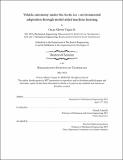| dc.contributor.advisor | Schmidt, Henrik | |
| dc.contributor.author | Viquez R., Oscar Alberto | |
| dc.date.accessioned | 2022-08-29T16:20:57Z | |
| dc.date.available | 2022-08-29T16:20:57Z | |
| dc.date.issued | 2022-05 | |
| dc.date.submitted | 2022-06-23T15:04:35.287Z | |
| dc.identifier.uri | https://hdl.handle.net/1721.1/144919 | |
| dc.description.abstract | The use of autonomous vehicles has been growing across the globe, driven by their ability to meet the diverse needs of industry and scientific applications. Terrestrial and aerial uncrewed vehicles typically benefit from high-throughput communication systems which enable accurate positioning and operator input; Autonomous Underwater Vehicles (AUVs), however, generally require a higher degree of autonomy as they must rely on much more limited communication links and lack access to global navigation satellite systems (GNSS) while underway. This distinction becomes especially important in hazardous environments like the Arctic Ocean, where surface ice may impede an AUV from breaching to regain access to position and controller updates. Instead, underwater vehicles in ice-covered environments require a higher level of autonomous decision-making, and rely on a combination of self-contained sensors and acoustic positioning networks for navigation – but the latter generally rely on a deterministic conversion of acoustic travel times to ranges, failing to capture the natural variability of the acoustic environment.
This dissertation demonstrates the application of physics-based machine learning techniques as an alternative to deterministic solutions for environmental adaptation in unmanned vehicle auton- omy. This is achieved by gradually incrementing the complexity of the adaptation problem: first, the tasks of behavior identification and riverbed characterization are tackled with a classification approach; next, an embedded acoustics model is used in place of the conventional linear model for acoustic positioning, and a feature design approach is employed to improve the performance of this embedded range estimation; last, a pseudo-tomographic approach based on neural network tech- niques is proposed as a complement to compressive sensing, to enable exploratory environmental adaptation onboard AUVs.
The improvements to acoustic positioning are validated against data collected in the Beaufort Sea in March of 2020, where the presence of the Beaufort Lens combines with the surface ice covering the Arctic Ocean to create an ideal setting in which to demonstrate the importance of environmental adaptation. These capabilities may impact monitoring efforts in the area, which has seen increased interest from fishing, trade and military operations, and is of significant importance to understand- ing climate conditions. | |
| dc.publisher | Massachusetts Institute of Technology | |
| dc.rights | In Copyright - Educational Use Permitted | |
| dc.rights | Copyright retained by author(s) | |
| dc.rights.uri | https://rightsstatements.org/page/InC-EDU/1.0/ | |
| dc.title | Vehicle autonomy under the Arctic ice: environmental adaptation through model-aided machine learning | |
| dc.type | Thesis | |
| dc.description.degree | Sc.D. | |
| dc.contributor.department | Massachusetts Institute of Technology. Department of Mechanical Engineering | |
| dc.identifier.orcid | https://orcid.org/0000-0001-9697-0420 | |
| mit.thesis.degree | Doctoral | |
| thesis.degree.name | Doctor of Science | |
